Certificates were issued for most runs, but the World 24 hour relay certificate where a world record was set by the Traralgon Harriers and signed by Ron Clark is probably the most cherished.
First pack run for the new Harriers must have been run on Wednesday June 25th, 1967, but was soon moved as Thursday night was most suitable for members, as shown in the following article:
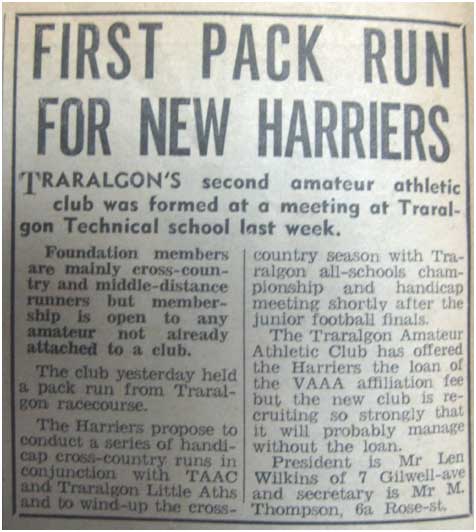 First Pack Run The Journal – Thursday, June 29, 1967, page 18
First Pack Run The Journal – Thursday, June 29, 1967, page 18
The Harriers Uniform is based on the colours of the Arthur Liddiard era (New Zealand) and Palmerston North Athletic Club Colours i.e. basic black with a Silver Fern.
The distinctive “T” on the original uniform also originates from St. Paul’s Catholic College (now Lavalla). This “T” also featured on the white Traralgon Amateur Athletic Club uniform. The black uniform was adapted from New Zealand’s National uniform.
The Traralgon Harriers had a strong recruitment campaign and it wasn’t long before they became the strongest club in Gippsland (and sometimes country Victoria)… the Harriers competed in the Victorian Track and Field Championships and Victorian All Schools Cross-Country Championships.
The Traralgon Harriers conducted the Athletic Club 24 hour relay in March 1969 where they set a world record of 323 Miles 386 Yards which is still held today (Ron Clark signed the certificates of merit).
The 24 hour relay was held opposite the Outdoor Swimming Pool run on the flat part of the center medium strip in Kay Street. It was shared with approx. 60 people (all were recognised) and were issued Certificates…same as the one given to Keith Tomholt.
Refer to APPENDIX 1 – World 24 Hour Relay Record video footage. Participants were Martin and Leigh Thompson, Richard Jeffery, Bruce Inglis, Keith Tomholt and others.
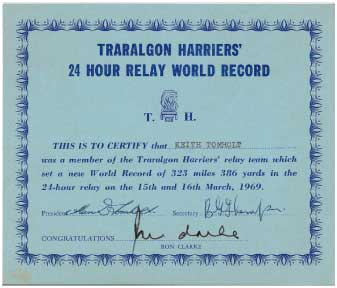 Traralgon Harriers’ 24 Hour Relay World Record
Traralgon Harriers’ 24 Hour Relay World Record
Following two extracts from 1967 Express and Journal articles contain a small contradiction about the exact date of formation, but are consistent within the month and year, and within a two week period.
The Journal. Thursday, June 29, 1967, page 18:
“Traralgon’s second amateur athletic club was formed at a meeting at Traralgon Technical School last week.”
“The Harriers propose to conduct runs in conjunction with Traralgon Amateur Athletic Club (TAAC) and Traralgon Little Aths.”
Note. “ . . last week . . ” would have been the week Monday 19 – Friday 23th of June 1967.
* Barry Thompson, The Express, Wed July 5, 1967, page 25:
“ the formation last Wednesday of (sic) Traralgon Harriers.”
The previous Wednesday was June 28, 1967.
Both statements identify a two week period from June 19th to June 30th 1967. (It is possible the dates were confused between the two articles.)
* Barry Thompson was the instigator, and ‘founder’ of the Harriers, and was a teacher at Traralgon Technical School at that time.
To overcome this issue at the Annual General Meeting on the 24th April 2014 a motion was carried to formally recognise the formation date of the Traralgon Harriers as June 1967.
From Martin Thompson
Regarding the formation of the Harriers club “….I recall the meeting which was held in one of the old shelter sheds at Traralgon Technical School which had been a store-room for some sports equipment and served as BGs (Barry G Thompson’s) office. A small group attended maybe about 8-10 distance runners. ….”
“…. It is preposterous to be suggesting that the formation of the Harriers was any other date other than mid-1967. The Harriers club was formed by and for distance runners in 1967.
In 1966 there was a spread of athletes (male and female of all ages, track and field and cross country) who competed for the Traralgon Women’s Amateur Athletic Club and the Traralgon Amateur Athletic Club (male) in the Latrobe Amateur Track and Field Centre. In 1965 there were a handful of athletes (including my brother and sister) from Traralgon who were registered and competed for the Morwell Amateur Athletic Club. Relations between Traralgon athletes and the Latrobe Valley Amateur Athletic Centre were less than harmonious during 1967 and 1968. Traralgon Harriers wanted more distance running events on the race calendar and some autonomy from the Latrobe Amateur Athletic Centre. To be recognised as an “Athletic Centre” where three clubs and a Centre could organise athletic competition became the catalyst for the formation of Traralgon Harriers. Many young distance runners mainly from Traralgon Technical School joined the Traralgon Harriers at my invitation along with a few of their counterparts at the Traralgon High School and St Paul’s College. The Traralgon Harriers had a strong recruitment campaign and it wasn’t long before they became the strongest club in Gippsland (and sometimes country Victoria)… The Harriers competed in the Victorian Track and Field Championships, Victorian All Schools Cross-Country Championships and conducted the Athletic Club 24 hour where they set a world record (Ron Clark signed the certificates of merit). I undertook coaching many junior runners who had joined the Harriers … and these junior runners went on to win many major races … Often we met at the junction of Traralgon Creek and Jeeralang Creek out past Traralgon South to run a 21 mile training course up in the Strzelecki Ranges … finished off with a cup of tea/toast and a few long yarns.
The formation of Traralgon Harriers brought together some wonderful people … a couple of years ago we had a small Sydney based reunion … I then realised that the Club provided me with some life-long friendships … and as I listened to John Bermingham describe his attempt to break the 4.00 minutes for the mile on an indoor board track in New York, racing against the Kenyan Mike Boit and the Irish world record holder Eamon Coghlan … it was a great memory re-told by the former St Paul’s secondary school student who joined the Harriers in 1967!!!“
Regards
Martin
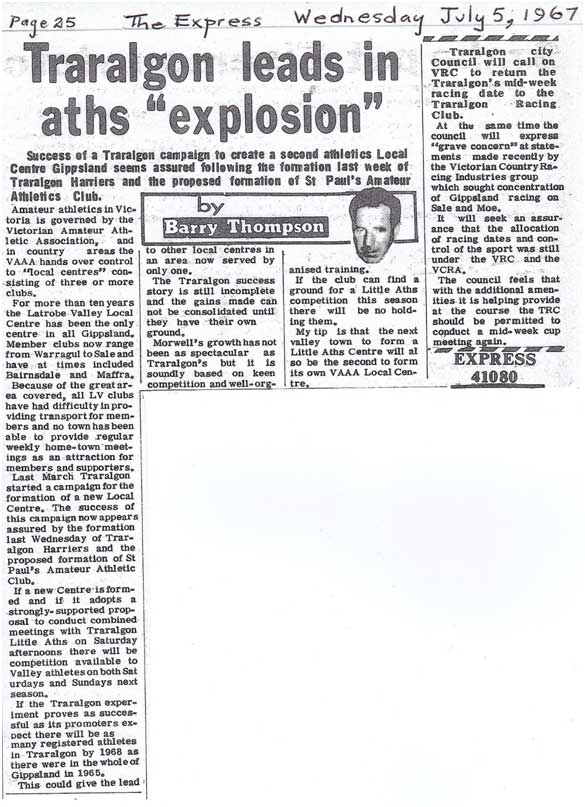 Traralgon Harriers Formation by Barry Thompson, The Express, Wed July 5, 1967, page 25
Traralgon Harriers Formation by Barry Thompson, The Express, Wed July 5, 1967, page 25
Chris Collins, Wally Phillips, Martin Thompson, Leigh Thompson and John Turpin were founding members of Traralgon Harriers Amateur Club.
Robert Wood, Garry Henry, Robert Cooper, Scott Rae, Keith Tomholt, Bruce Inglis, John Pollard, Ian Cummings, Juris Puce were some who joined in the club’s early years, later Richard Jeffrey was recruited.
Rex Perkins and Swaggy (Geoff) Wilson joined following the demise of Traralgon Amateur Athletic Club (TAAC).
John Bermingham in 1969 was studying Latin at St Pauls and it was he that translated a very common saying of Barry Thompson’s into Latin. It didn’t sound so crude in Latin!
The club adopted a badge with an eagle in full flight and those words wrapping around underneath the bird as the club motto.
Original cloth badge featured a Flying Pigeon with the motto in Latin.
“Omnia Abiecta Faecii” was the club motto and featured a flying pigeon.
Traralgon Harriers did not approve of club members dropping out of a race.
A brother at St. Paul’s Catholic College provided the Latin.
I understand it to mean “All that drops out is shit”.
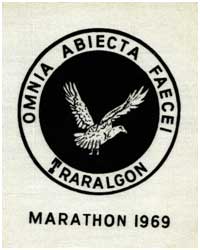 1969 Traralgon Harriers Marathon Badge
1969 Traralgon Harriers Marathon Badge
Together Barry Thompson and Martin Thompson were instrumental in starting the Traralgon Harriers Amateur Athletic Club. Under the Victorian Amateur Athletic Associations (VAAA) rules clubs were not able to hold an athletic meeting on a weekend where there was an interclub meeting being conducted by their local centre The Latrobe Valley Amateur Athletic Centre (LVAAC). In order to overcome the problem of transporting more than half the athletes competing at a LVAAC athletics meeting, a Traralgon Amateur Athletic Centre was formed so Traralgon based competition could occur.
The foundation clubs were the original Traralgon Amateur Athletic Club (AAC), Traralgon Harriers AAC and the Achilles AAC. Traralgon Harriers were first formed and then shortly afterwards the Traralgon Amateur Athletics Centre was formed.
Moves were also being made to form a Glengarry/Tyers AAC, St Michaels/St Pauls AAC and a Yarram AAC. As Women’s and Men’s Athletics Associations were separate State organisations TWAAC were not considered a part of the Traralgon Centre by the Victorian AAA even though they competed alongside the men.
Traralgon Harriers was the smallest club with Martin Thompson, Leigh Thompson, Chris Collins, Wally Phillips and a few others. The Traralgon Harriers Club members were generally the distance runners not the sprinters, middle distance or field events athletes. The Traralgon Centre also conducted Little Athletics meetings on Saturday mornings.
As only one LVAAC athlete came from Sale, moves were made to define the boundaries of the Traralgon Amateur Athletics Centre by extending it east and calling it the East Gippsland Amateur Athletic Centre. The LVAAC boundaries were to be from west of Traralgon to east of Dandenong. The VAAA in its “wisdom” decided that the boundaries of the Latrobe Valley Amateur Athletic Centre would extend from east from Warragul (or Drouin or Dandenong) to the NSW border and its name be changed to East Gippsland Amateur Athletics Centre. While the Latrobe Valley Amateur Athletic Centre may have been pleased that this boundary decision effectively eliminated the Traralgon Amateur Athletic Centre, the inappropriate and unwanted name change meant the that considerable sum spent in designing and making a die for award medals was wasted. This decision put an end to the Traralgon Athletic Centre and eventually led to the demise of all local clubs except the Traralgon Harriers.
At a subsequent VAAA delegates meeting the renaming of LVAAC was later reversed with the support of Traralgon based clubs.
In the 1960 Rome Olympic Games New Zealand coach Arthur Lydiard, trained two gold medalists Peter Snell (1500m) Murray Halberg (5000m) and bronze medalist Barry Magee (Marathon). The main feature of Martin’s training for Traralgon Harriers was to run 100 miles a week as Arthur Lydiard’s runners did. The black uniform was influenced by New Zealand’s Olympic uniforms. The distinctive T originated from St. Pauls Catholic College Traralgon and was worn by TAAC (white tops) and THAAC (black tops) athletes.
The Traralgon Harriers became incorporated on the 11th October, 1985.
Relevant documents: Minutes of meeting, Statement of Proposes, Certificate of Incorporation
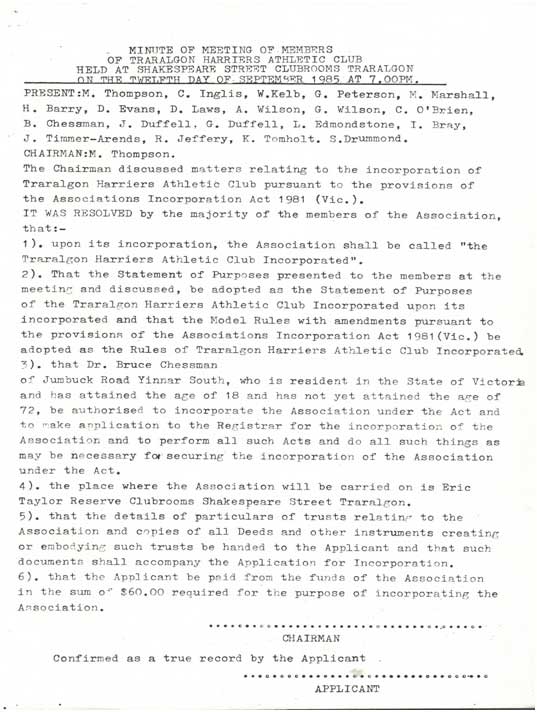 Minutes of meeting – Includes matters discussed relating to the incorporation
Minutes of meeting – Includes matters discussed relating to the incorporation
The Objectives are intended to provide a framework for the club’s programs and activities.
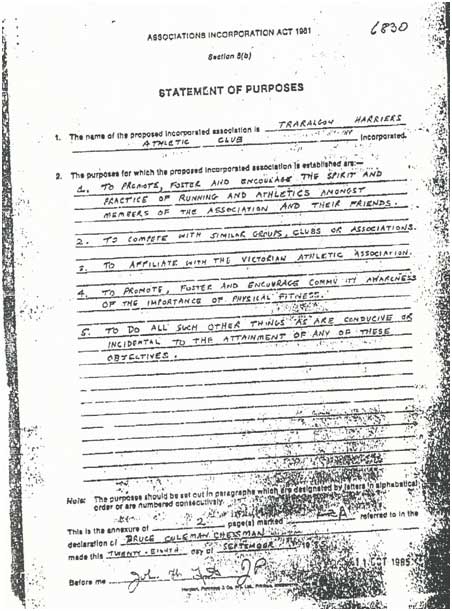 Statement of Purposes – Club Objectives were based on these
Statement of Purposes – Club Objectives were based on these
Showing the Registered No. 6830 and date of Incorporation 11th October 1985:
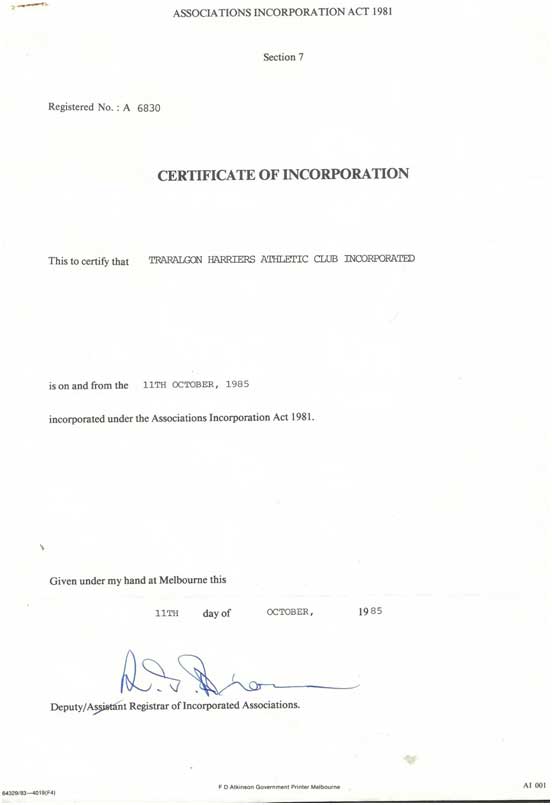 Certificate of Incorporation
Certificate of Incorporation
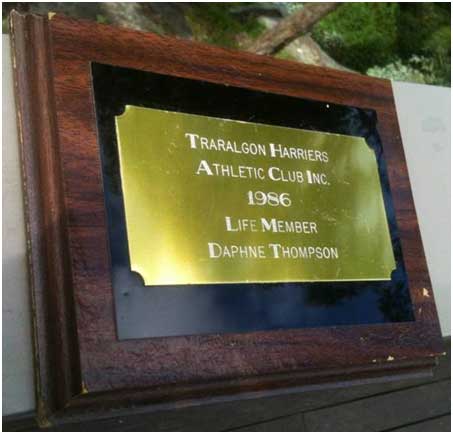 First Traralgon Harrier Life Membership plaque – Daphne Thompson
First Traralgon Harrier Life Membership plaque – Daphne Thompson
Tribute to Daphne Thompson
Notice in Traralgon Harriers newsletter at the time of Daphne’s passing:
THOMPSON, Daphne (Died 8 April 1989)
Traralgon Harriers Athletic Club Inc. wishes to acknowledge the contribution to athletics made by their life member Daphne Thompson by her active participation in both the Traralgon Women’s Amateur Athletic Club and Traralgon Harriers, she helped found and sustain a unique club that has given opportunities for recreation fellowship and completion to a generation of runners.
Thank you Mrs. T.
Barry and Daphne were married in Darwin. He enlisted in the RAAF on 29 June 1944. He was a top boxer in the RAAF for his weight. Barry went with the British and Commonwealth Occupation Forces (BCOF) to Japan where he became fluent in both Japanese and German. He always had a flair for learning languages. He was discharged from the RAAF on 29 April 1948. Sometime later he commenced building around Lindenow where he also played football.
Information supplied by Leigh Thompson
Daphne May ALLEN born 23 October 1919 Bathurst NSW and died 8 April 1989 in Bairnsdale.
Daphne was a good runner at school (sprints) and also played some tennis and from 1950 onwards. Her older brother had had a futile attempt at Emile Zatopek’s 5000 m record. In the early 1960’s Barry was a volunteer gymnastics instructor for the Police Boys club while Daphne was closely involved with playing and organising table tennis. Daphne started teaching at Traralgon High School (THS) in 1958 on the proviso that she could attend the Victorian Country Week Table Tennis Championships each year. Every Friday, THS had electives activities over the last two 40 minute periods following the afternoon recess. Daphne ended up initiating a table tennis activity which soon became the largest activity (nearly 200 students) with students heading down to the Showgrounds Table Tennis pavilion as soon as afternoon recess started and for those who could, staying on till well after school had finished. She mainly taught Geography and History initially then later Science, Physical Education and English. She took Sport activities especially Athletics, Table Tennis, Tennis, Hockey and more.
Daphne was always keen on athletics and attended the 1956 Olympic Games as a spectator with Martin her son.
At Traralgon High School she screened the films of each Olympic Games thereafter enthusing many students.
Daphne started the TWAC Traralgon Women’s Athletic / alongside the Harriers Club and was the Secretary for some time of the Traralgon Harriers.
Daphne was always there for the regular Thursday night runs (no matter what the weather was like) to collect a fee from each of the runners (in the mid 1980’s the fee was $2). This commitment created an accumulation of funds which gave the club a solid financial basis, providing funds to draw on to build our new clubrooms and still left enough funds for the club to be in a very sound financial positon. Recognising Daphne Thompson in the Traralgon Harriers historical highlights is most appropriate as she was our first Life Member
Information supplied by Leigh Thompson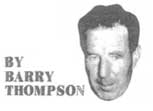 Barrymore Gilbert THOMPSON born in Bairnsdale 15 June 1926 and died 4 November 1982 in Traralgon
Barrymore Gilbert THOMPSON born in Bairnsdale 15 June 1926 and died 4 November 1982 in Traralgon
Barry was a builder. In the 1960’s he was recruited to teach woodwork at Traralgon Technical School. It was soon discovered that he was a whiz at Mathematics and English so he taught these subjects as well. His interest in Science led to him teaching this as well as Physical Education. He also took sport and frequently took students on cross country runs towards Tyers where he ran with the students and had a swim.
Barry tutored mathematics to Martin and several of his classmates on a regular basis mostly in 1959 and 1960. He and Martin taught together at the Technical School. There they built the Gymnasium (a varied Supa Welds shed) and demolished, transported and re-erected surplus buildings donated by the Australian Paper Mill.
Barry competed socially as a runner and was only occasionally competitive when running with Keith Tomholts father (Alan), on the track at the Traralgon showground’s and in an occasional short road race. Barry’s sports portfolio in chronological order was: boxing, football, table tennis, tennis, athletics, distance running, cycling. He once ran about the first 20 miles of a marathon.
The founding member of the Traralgon Harriers, the late Barry Thompson was responsible for the inaugural and subsequent Traralgon Marathons from 1968 and over the next ten years or so.
Respected Harrier member Bruce Salisbury said, “The club was formed in 1967, and was affiliated with the Victorian Amateur Athletics Association the same year.”
As other clubs in Gippsland faded over the years, the Harriers became a regional club by default. Members now live anywhere within a 50 kilometres radius of Traralgon, and beyond.
Bruce said, “The Thompson family was heavily involved in its formation, with Barry Thompson becoming the first secretary. “
“Barry, his wife Daphne, daughter Dale and sons Martin and Leigh were central to the club over many years.”
“The club ran all distances, from sprints to marathons, and was also involved in field games. The focus then shifted, with the club now being a distance running club,” he said.
From a base of little or no female participation in the early days, the Harriers now have an even mix of men and women runners, of all ages. As an ex Harriers’ president Carol Summersgill explains, “We are a family club.”
Barry enjoyed nothing more than to encourage athletes of all levels to achieve their personal goals, particularly over the challenging marathon distance. Barry would get out of his car and jog with anyone who he thought was flagging and with his many and varied pearls of wisdom would encourage them to continue. Whether you ran 5 hours or 2 hours 10 mins, Barry would always applaud your performance and respect your resolve to achieve your best. The Thompson family commissioned a local artist to create the BG Thompson memorial marathon trophy which is a highly sought after award.
**************************
THE CHAMPION OF CLUBS
**************************
Uphill roads are toughest.
They’re a test of men
Put your best foot forward.
Climb that hill again.
Harriers are triers,
Always do their best
Runners are real men,
Rubbish to the rest!
If you feel downhearted;
Even if you fail,
Run and keep on running
Scorn to show a ‘tail’.
Fortune smiles on brave lads,
Who run their guts right out.
Useless to deny this,
Or skite and shout.
“Clarkey” is our model,
Tried and tough and true;
King of distance runners,
From here to Timbuctoo.
After all the weakies
Have faded out and died
Clark and Derek Clayton,
We’ll speak of them with pride.
Harriers keep training
In weather foul or fair.
Let us run the hard roads
Like this immortal pair.
Early in the morning,
And when the sun has set
Strive to make a good club,
Great and greater yet.
B.G.Thompson
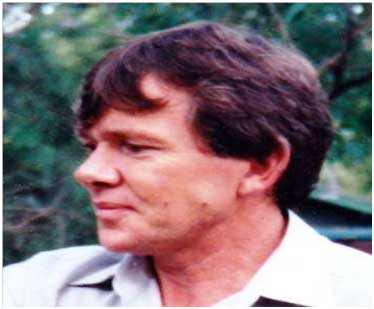 Martin Thompson
Martin Thompson
Article from the Harriers Weekly Newsletter April 7th 2016 by Geoff Duffell.
Vale Martin Thompson (Died 3rd April 2016)
Martin Thompson: Harriers founding member, coach and motivator, club administrator, life member, international athlete, teacher, sports scientist.
Martin Thompson’s recent passing (3 April) means the loss of one of the most influential figures in the club’s history. Martin inspired and motivated many.
In the early days he turned local runners into junior Victorian champions, and inspired many others to achieve outstanding running results. He served many years in club administration roles where his innovative ideas and sound judgment helped in early club building.
In the 1970’s Martin spent several years in England where he studied and trained, running over 100 marathon and ultramarathon events. He was particularly successful in the ultramarathon events with many top placings and several Australian records. His wife Linda also competed successfully in many of these events.
On their return in 1979, Martin and Linda had joint wins in the Traralgon Marathon. They left Traralgon for Sydney some 30 years ago for Martin to take up a university teaching and research position. Despite his Sydney commitments, he maintained local connections and a continuing interest in the club’s progress.
Martin’s legacy to the club can still be seen. In the club’s early years the stringent requirements of amateurism meant strict oversights on every club’s rules and activities. Martin thought that democracy, with decisions entirely in the hands of members, was more important. He devised club by-laws as a means to enable greater club autonomy and member democracy.
In the mid-1970s another of Martin’s ideas was to implement mid-week runs which, under the prevailing rules, were not strictly legal. They were an immediate success. Martin had sensed a turning tide in the emergence of fun running, with its wide popular appeal, suddenly outstripping interest in track events.
In Sydney, Martin’s contribution to the wider running world was orientated towards practical applications. For example, he used techniques for enhanced treadmill training with runners he coached. Two of them won national championships.
A major area of Martin’s experimental studies was into exercise in hot and humidity conditions. His expertise was called on to assist Olympic squads with their event preparation and heat acclimatisation programs.
In recent years Martin had had a number of overseas trips where his technical knowledge on training principles and advice on sports programs had been sought.
Perhaps Martin’s life approach is best summed up by a sticker he once had on his car:
“Jog a bit. It keeps you fit.”
Our sympathies go to Martin’s family, particularly his wife Linda, brother Leigh and sister Dale, all of them runners and contributors in the early years of our club.